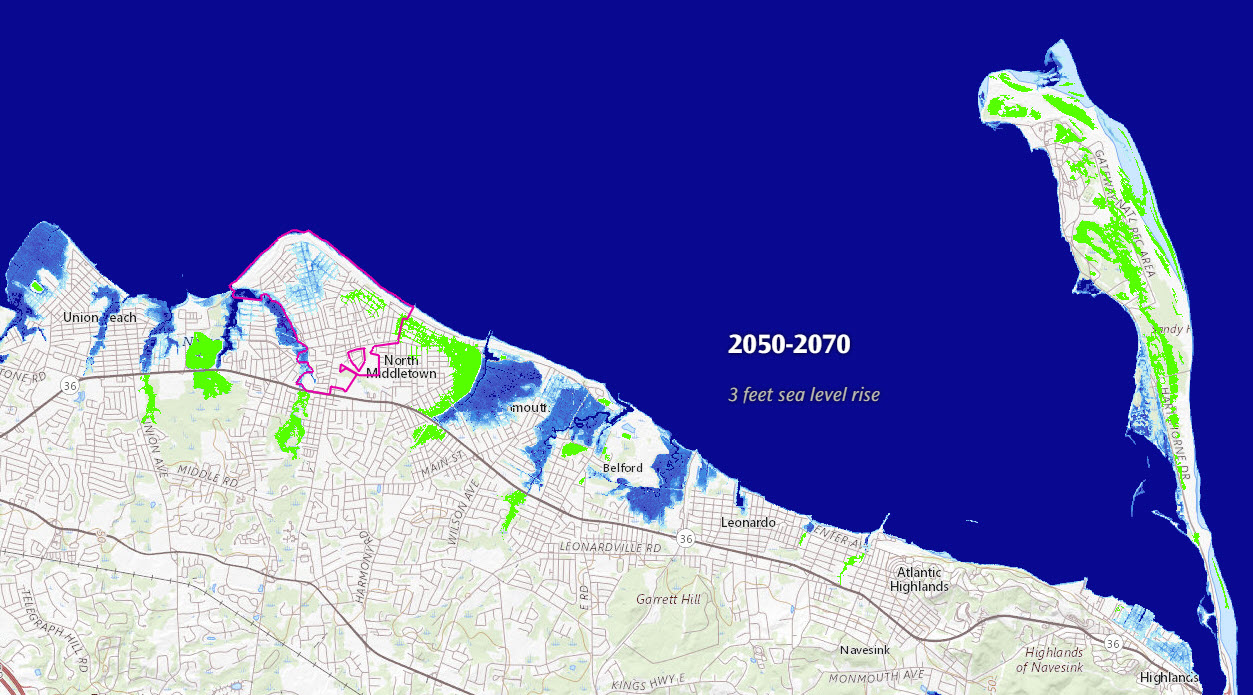Keansburg
Atlantic Highlands
- StoryMap
- Water Dependent Uses
- Opportunities and Constraints
- Nature-Based Solutions
- Flood Vulnerability Assessment
Final Presentation
Bloustein Fall Coastal Climate Resilience Studio Course: Integrating Climate Change Resilience into the New Jersey State Planning Commission Plan Endorsement Process Pursuant to Executive Order 89
The 1986 New Jersey State Planning Act (N.J.S.A. 52:18A-196 et seq.) establishes the NJ State Planning Commission (SPC) and the Office of Planning Advocacy (OPA). The Act called for a State Development and Redevelopment Plan to be prepared through a statewide planning process and it establishes Plan Endorsement as a voluntary process by which municipalities may have their local plans reviewed by the SPC. Plan endorsement expands upon the minimum requirements of the Municipal Land Use Law and it is through Plan Endorsement that local, county and State governments are intended to work together to develop coordinated capital investment and planning implementation mechanisms that are consistent with the State Plan and with each other. Completion of the Plan Endorsement requirements makes the petitioner eligible for a host of benefits provided by State agencies. See: https://nj.gov/state/planning/plan-endorsement.shtml.
On October 29, 2019, Governor Phil Murphy issued Executive Order 89 directing a suite of governmental actions on climate change resilience. Among other actions, the directs the Department of Environmental Protection to prepare a Scientific Report on Climate Change and a Statewide Climate Change Resilience Strategy by May and September 2020, respectively. Section 7 of the Order directs the SPC to apply the Scientific Report and Resilience Strategy to incorporate climate change considerations, such as increasing temperatures, rising sea levels, increased flooding, and increased vulnerability to droughts and forest fires, as a mandatory requirement for Plan Endorsement of the development and redevelopment plans of local units of government. The SPC shall, consistent with the Administrative Procedure Act and as necessary or appropriate, amend its regulations to incorporate these climate change considerations.
The client for this fall 2020 Bloustein resilience studio course is the state OPA and the studio focus is on supporting OPA’s effort to incorporate resilience into the Plan Endorsement process pursuant to Executive Order 89. The studio will accomplish this objective by working with two towns in Monmouth County undergoing Plan Endorsement by supporting development of municipal resilience plans that will serve as replicable templates for OPA resilience planning provisions. In addition to providing support to the two municipalities, students in the studio will also offer OPA recommendations on elements of its Plan Endorsement rulemaking based on their experience working with the two municipalities.
This studio is well-suited for students who have an interest in the following topics:
- Impacts of changing climate conditions on built and natural infrastructure, cultural and historic resources, social and economic systems, and vulnerable populations;
- Strategies to assess a region’s vulnerability to future climate conditions and approaches to address vulnerability as part of integrated planning efforts;
- Intersection of state policy informing local planning;
- Equity considerations with regard to climate resilience; and
- Communication of risk and uncertainty in planning, decision-making and public engagement.
In addition to Bloustein graduate planning students, this studio course will include participants from the Rutgers Coastal Climate Risk and Resilience training program which includes graduate students in the natural and engineering sciences that are involved in research and coursework designed to foster broad exploration of the intersection of disciplines to advance transdisciplinary solution-oriented perspectives to coastal climate risk.
Skills that will be used as part of the studio include quantitative data and statistical analyses; GIS; performance of key informant interviews; project management and client relations; policy and regulatory analyses; examination of existing planning documents to assess current planning efforts in light of future climate and environmental conditions; analysis of demographic and other information and data to discern trends in population, employment, and health; review of current built and natural systems and envisioning alternative designs that enhance resilience; assessment of socioeconomic impacts of various alternatives, etc.
Instructor: Jeanne Herb

